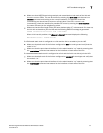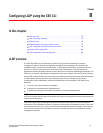68 Dell Converged Enhanced Ethernet Administrator’s Guide
53-1002116-01
Link aggregation overview
7
Link Aggregation Control Protocol
Link Aggregation Control Protocol (LACP) is an IEEE 802.3ad standards-based protocol that allows
two partner systems to dynamically negotiate attributes of physical links between them to form
logical trunks. LACP determines whether a link can be aggregated into a LAG. If a link can be
aggregated into a LAG, LACP puts the link into the LAG. All links in a LAG inherit the same
administrative characteristics. LACP operates in two modes:
• Passive mode—LACP responds to Link Aggregation Control Protocol Data Units (LACPDUs)
initiated by its partner system but does not initiate the LACPDU exchange.
• Active mode—LACP initiates the LACPDU exchange regardless of whether the partner system
sends LACPDUs.
Dynamic link aggregation
Dynamic link aggregation uses LACP to negotiate which links can be added and removed from a
LAG. Typically, two partner systems sharing multiple physical Ethernet links can aggregate a
number of those physical links using LACP. LACP creates a LAG on both partner systems and
identifies the LAG by the LAG ID. All links with the same administrative key and all links that are
connected to the same partner switch become members of the LAG. LACP continuously exchanges
LACPDUs to monitor the health of each member link.
Static link aggregation
In static link aggregation, links are added into a LAG without exchanging LACPDUs between the
partner systems. The distribution and collection of frames on static links is determined by the
operational status and administrative state of the link.
Dell-proprietary aggregation
Dell-proprietary aggregation is similar to standards-based link aggregation but differs in how the
traffic is distributed. It also has additional rules that member links must meet before they are
aggregated:
• The most important rule requires that there is not a significant difference in the length of the
fiber between the member links, and that all member links are part of the same port-group.
The ports that belong to port-group 1, port-group 2, and port-group 3 are te0/0 to te0/7, te0/8
to te0/15, and te0/16 to te0/23, respectively.
• A maximum of four Dell LAGs can be created per port-group.
LAG distribution process
The LAG aggregator is associated with the collection and distribution of Ethernet frames. The
collection and distribution process is required to guarantee the following:
• Inserting and capturing control PDUs.
• Restricting the traffic of a given conversation to a specific link.
• Load balancing between individual links.
• Handling dynamic changes in LAG membership.


















